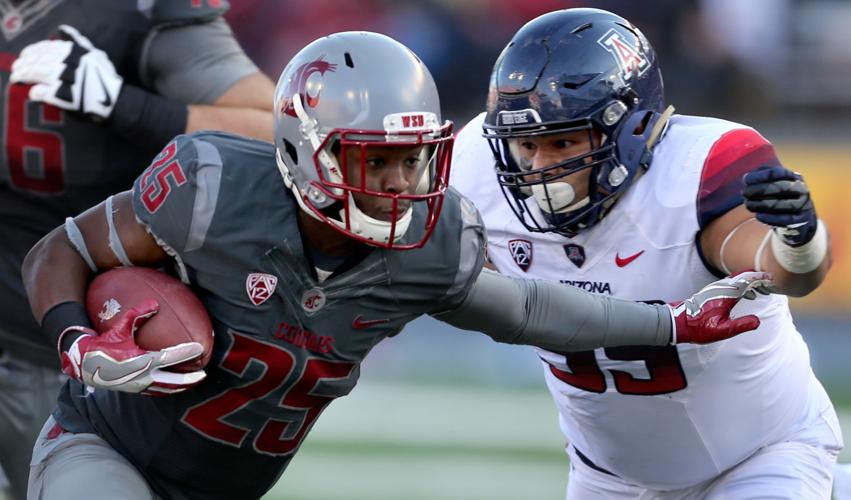The distance between Seattle and Pullman is 285 miles.
The distance between the Arizona Wildcats who faced Washington six weeks ago and the version that met Washington State on Saturday feels like light years.
Somewhere along the way, the Wildcats slipped into a black hole.
On Sept. 24, Arizona took Washington to overtime. The Huskies, ranked No. 9 at the time, escaped with a 35-28 victory. Arizona and Utah are the only teams that have come close to beating Washington, which is 9-0 and landed at No. 5 in the first College Football Playoff rankings.
On Saturday, Arizona never had a chance against Washington State. The Wildcats barely looked competitive in a humiliating 69-7 defeat — the UA’s most lopsided loss since Harry S. Truman was president. The setback was Arizona’s sixth in a row.
The goal for every team in every sport is to get better as the season progresses. So why have the Wildcats gotten worse? What has changed over the past six weeks?
Here are some of the main causes and effects:
THE INJURY FACTOR
It isn’t how many injuries Arizona has suffered so much as where they’ve struck.
Three positions have been hit the hardest: quarterback, running back and middle linebacker.
The Washington game was the last time quarterback Brandon Dawkins was fully healthy. The following week, against UCLA, he injured his ribs. The next week, at Utah, he suffered a concussion. He hasn’t been the same since.
In his first three games — Grambling State, Hawaii and Washington — Dawkins rushed 44 times for 391 yards and seven touchdowns, averaging 8.9 yards per carry.
In the past four games — UCLA, Utah, Stanford and Washington State — he has carried 42 times for 206 yards and one TD, averaging 4.9 yards per carry.
As a passer, Dawkins hasn’t look right since coming back from the concussion. In two games, he has completed 31.6 percent of his passes with one touchdown and two interceptions. Prior to that, he had completed 58.5 percent with five TDs and three picks.
Rich Rodriguez didn’t have Dawkins or fellow veteran Anu Solomon available for the Oct. 15 game against USC, forcing freshman Khalil Tate into the starting lineup. Tate struggled, and Arizona scored only 14 points.
Dawkins and Solomon — who had been out since the opener because of a knee injury – returned for the next game, on Oct. 29 against Stanford. Rodriguez has rotated the two since, which hasn’t produced the desired results.
Arizona scored only 10 points against the Cardinal, then seven against WSU. Saturday’s game marked the sixth game in a row that the Wildcats scored fewer points than the previous contest.
At running back, Arizona had sensational freshman J.J. Taylor available against the Huskies — until he suffered a season-ending broken ankle late in the third quarter. Taylor had 97 rushing yards at that point after gaining 168 against Hawaii.
With Nick Wilson also out of the lineup because of an ankle injury, and Orlando Bradford kicked off the team, the Wildcats were down to their fourth and fifth options. They couldn’t threaten defenses the same way.
Wilson made two subsequent appearances but couldn’t finish either game. He suffered a knee injury against USC that has him sidelined indefinitely.
Arizona turned to senior Samajie Grant the past two weeks, and the converted receiver has performed admirably. Grant has rushed for 141 yards on 27 carries, an average of 5.2 yards per attempt.
But the UA offense continues to stumble, unable to establish any semblance of continuity or rhythm.
At middle linebacker, Arizona had multiple options against Washington. Two weeks later, starter Cody Ippolito suffered a season-ending knee injury. Against Stanford, replacement Michael Barton also hurt his knee. He did not play against Washington State.
Would the presence of Ippolito and/or Barton have made a tangible difference against the Cougars? Maybe. Both are smart veterans who know how to read offenses and direct traffic.
Without them, the defense hardly put up any resistance.
MORE GIVE THAN TAKE
Heading into the Washington game, Arizona had a plus-five turnover margin. The Wildcats hung with and almost upset the Huskies despite a minus-two margin.
It has only gotten worse since then.
In the past four games, Arizona has turned the ball over 13 times. In the past five, the UA has only one takeaway.
Wildcats coaches and players agree: They simply aren’t good enough to overcome that big a disparity in turnovers.
The giveaway-takeaway deficit has resulted in a corresponding discrepancy in field position that repeatedly has put the defense in compromising situations. The offense rarely, if ever, starts a drive in enemy territory. Remarkably, it has happened only once in Pac-12 play.
Quarterbacks have been responsible for 11 of the 13 turnovers.
LACK OF DEVELOPMENT
This one is harder to quantify, aside from wins and losses. Where the fault lies also is not completely clear.
But it’s obvious that Dawkins hasn’t gotten better since he first started playing. Nor has the offensive line, which continues to suffer untimely and glaring breakdowns on a weekly basis.
The defense seemed to be trending in the right direction; in terms of yards allowed, it had its best game against Stanford.
But the Wildcats couldn’t rush the passer or cover against Washington State. For much of the game, it looked as if Cougars quarterback Luke Falk were running a 7-on-7 drill.
Special teams have been a season-long sore spot. Josh Pollack has performed well as a placekicker but has struggled as a punter; he gave way to Matt Aragon in the second half against WSU. Arizona’s longest kickoff return is 33 yards; its longest punt return, 22 yards.
It’s the coaches’ responsibility to get the most out of the players. As he readily would admit, Rodriguez and his staff haven’t gotten the job done in that regard.





